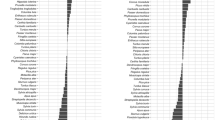Abstract
When analysing spatial pattern, aggregation and regularity are normally regarded as being mutually exclusive and a two-tailed test is applied to check whether or not there is a deviation from random expectation towards one or the other. However any fine-scale regularity occurring in crowded patches is likely to be masked by the larger-scale aggregation using this approach. An associated problem is that edge effects are particularly severe for small patchy populations. An inclusive analysis utilising one-tailed nearest-neighbour tests to check for aggregation and regularity separately is described. In addition the technique resolves the edge-effect problem. The approach is illustrated using a synthetic patchy population, and is then applied to a population of granite tors showing both large-scale aggregation and fine-scale regularity. Regular spacing of buzzard territories is discussed briefly.
Similar content being viewed by others
References
Brown D, Rothery P (1978) Randomness and local regularity of points in a plane. Biometrika 65:115–122
Campbell DJ (1990) Resolution of spatial complexity in a field sample of singing crickets Teleogryllus commodus (Walker) (Gryllidae): a nearest-neighbour analysis. Anim Behav 39:1051–1057
Campbell DJ (1992) Nearest-neighbour graphical analysis of spatial pattern and a test for competition in populations of singing crickets (Teleogryllus commodus). Oecologia 92:548–551
Campbell DJ (1995) Detecting regular spacing in patchy environments and estimating its density using nearest-neighbour graphical analysis. Oecologia 102:133–137
Campbell DJ, Clarke DJ (1971) Nearest neighbour tests of significance for non-randomness in the spatial distribution of singing crickets (Teleogryllus commodus (Walker)). Anim Behav 19:750–756
Clark PJ, Evans FC (1954) Distance to nearest neighbor as a measure of spatial relationships in populations. Ecology 35:445–453
Diggle PJ (1983) Statistical analysis of spatial point patterns. Academic Press, London
Donnelly KP (1978) Simulations to determine the variance and edge effect of total nearest-neighbour distance. In: Hodder IR (ed) Simulation methods in archaeology. Cambridge University Press, Cambridge, UK, pp 91–95
Hodder IR, Orton CR (1976) Spatial analysis in archaeology. Cambridge University Press, Cambridge, UK
Krebs CJ (1989) Ecological methodology. Harper and Row, New York
Pielou EC (1962) The use of plant-to-neighbour distances for the detection of competition. J Ecol 50:357–367
Pinder DA, Witherick ME (1972) The principles, practice and pitfalls of nearest-neighbour analysis. Geography 57:277–288
Poole L, Borchers M (1979) Some common basic programs, 3rd edn. Osborne McGraw-Hill, Berkeley, Calif
Ripley BD (1979) Tests of “randomness” for spatial point patterns. J R Stat Soc B 41:368–374
Ripley BD (1981) Spatial statistics. Wiley, New York.
Ripley BD (1985) Analyses of nest spacings. In: Morgan BJT, North PM (eds) Statistics in ornithology. Springer, Berlin Heidelberg New York, pp 151–158
Sinclair DF (1985) On tests of spatial randomness using mean nearest neighbor distance. Ecology 66:1084–1085
Tubbs CR (1974) The Buzzard. David and Charles, London
Upton GJG, Fingleton B (1985) Spatial data analysis by example, vol 1. Wiley, Chichester
Zar JH (1984) Biostatistical analysis, 2nd edn. Prentice Hall, NJ
Author information
Authors and Affiliations
Rights and permissions
About this article
Cite this article
Campbell, D.J. Aggregation and regularity: an inclusive one-tailed nearest-neighbour analysis of small spatially patchy populations. Oecologia 106, 206–211 (1996). https://doi.org/10.1007/BF00328600
Received:
Accepted:
Issue Date:
DOI: https://doi.org/10.1007/BF00328600




